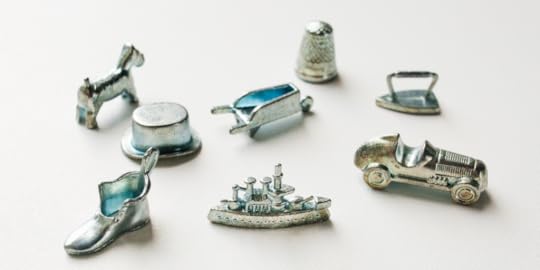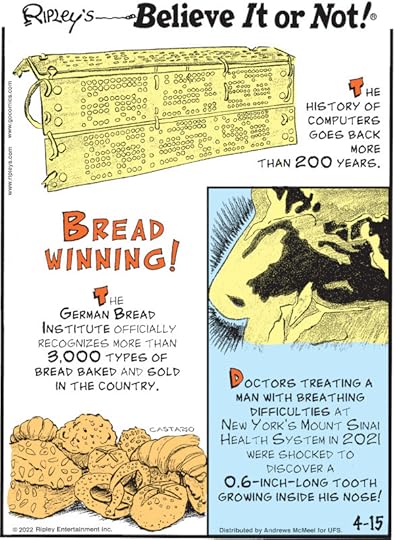Ripley Entertainment Inc.'s Blog, page 92
April 19, 2022
CARTOON 04-19-2022
April 18, 2022
CARTOON 04-18-2022
April 17, 2022
CARTOON 04-17-2022
April 16, 2022
CARTOON 04-16-2022
April 15, 2022
Not Just Allergies: Gardener’s Itchy Eye Caused By Fly Larvae
Featured in Ripley's Believe It or Not!

Bees are buzzing. Birds are chirping. Flowers are blooming. People are sneezing. It must be allergy season! As people across the Northern Hemisphere began stocking up on antihistamines, one man in France found himself dealing with much more than pollen making his eyes itch after doctors discovered over a dozen larvae living under his lids!
Giving New Meaning to “Bug-Eyed”Doctors at France’s University Hospital of Saint-Etienne made an eye-opening discovery when a 53-year-old man showed up in their emergency room complaining that his right eye had been itching for hours since he felt something crawl inside it while gardening near a horse and sheep farm.
Upon evaluating the situation, they were shocked to find more than a dozen translucent larvae squirming all over his conjunctiva and cornea, a diagnosis common enough to have an official name: external ophthalmomyiasis. The medical team went to work on physically removing the larvae, using forceps to grab them one by one.
Causing a Larvae Trouble
Image Challenge Follow-up: A 53-year-old man presented with itching of the right eye after gardening near a sheep farm. On examination, numerous mobile, translucent larvae were observed. https://t.co/EAf9mDYqi0 pic.twitter.com/8FtwWBBUqj
— NEJM (@NEJM) April 11, 2022
This isn’t the first time these juvenile delinquents have wreaked havoc for innocent bystanders. Back in 2020, a 25-year-old Australian woman finally found relief after seven years of horrible headaches when doctors discovered tapeworm larvae taking up brain space.
Another, sadly more common, instance is that of human botflies, which hitch rides into human skin via blood-sucking mosquitoes. Once the mosquito bites, it’s go time for these baby botflies to create a pus-filled home under the skin, where they live, grow, and thrive for five to ten weeks before catapulting themselves out of the body and into adulthood.
A Not-So-Sheepish FlyIn the case of the French gardener, the culprit turned out to be a pregnant sheep bot fly, or Oestrus ovis, with her sights set on a unique birthing location for her brand new babies.
This fly species is known for spreading parasitic infections in sheep populations worldwide. The larvae pose a significant threat to the cornea if not treated, as they have “oral hooks” and “body spicules” that can cause serious damage.

Fortunately, the gardener arrived early enough to prevent such damage and was seeing clearly as of his 10-day follow-up, where he reported that all symptoms had ceased after the removal.
By Meghan Yani, contributor for Ripleys.com
EXPLORE THE ODD IN PERSON! Discover hundreds of strange and unusual artifacts and get hands-on with unbelievable interactives when you visit a Ripley’s Odditorium!Source: Not Just Allergies: Gardener’s Itchy Eye Caused By Fly Larvae
CARTOON 04-15-2022
April 14, 2022
The Legend Of Shep, The Dog Who Never Stopped Waiting
Featured in Ripley's Believe It or Not!

Remarkably, dogs have been our loyal companions, hunting partners and best friends for perhaps 400 centuries. It’s estimated that humankind domesticated dogs between 20,000 and 40,000 years ago! In all that time, it seems there’s rarely been a more loyal, or iconic, canine friend than Shep.
The Tragic Loss of a Best FriendThe legend of Shep began in Fort Benton, Montana. In 1936, St. Clare Hospital had a seemingly unassuming patient: a sheepherder. The livestock wrangler’s name is unknown, but their faithful pet would soon become the stuff of legend.
This companion was a sheepdog who waited outside the hospital every day, not allowed to enter but cared for by staff who noticed his dedication. Perhaps the dog knew that his friend wasn’t long for this world, for the sheepherder sadly died not long after beginning their stay at St. Clare.
It was decided that Shep’s best friend was to be transported by train so the body could be laid to rest near the deceased’s family, who lived to the east. Undertakers prepared the body for the trip, and as it was being placed on board for its final journey, Shep watched from the train platform.
As in so many heart-wrenching movies, the dog is said to have followed for a moment as the train gathered speed, watching sadly as it traveled out of sight. For the rest of Shep’s life, he would be a train station icon, appearing every day in hopes that his master would return by rail.
According to one report, the stray dog was very wary of the people at the station at first, and he had a tendency to hide himself away in shadowy corners of the platform as he awaited the next train. As he became more and more of a fixture, though, the staff gained his trust, fed and cared for him, and gave him the name Shep.
Fort Benton’s Four-Legged CelebrityShep could have simply been disregarded as a stray and shooed away, but instead he became a local celebrity. The report goes on to say that many Fort Benton residents wanted to become Shep’s new owner, but the station was the one and only home he wanted — just in case his lost master returned.
So popular was Shep that he began to receive fan mail, and huge quantities of it too: station general manager T. F. Dixon assigned the job of trawling through all of Shep’s adoring mail to his secretary!
There’s no doubt that Shep had become a true superstar. Some travelers came to the station simply to catch a glimpse of him! In fact, he was even featured in a 1939 “Believe It or Not!” cartoon panel drawn by Robert Ripley himself.

The inclusion of Shep in the world-famous “Believe It or Not!” cartoon further catapulted the faithful dog into fame.
Faithful Till His Last BreathOn the morning of January 12, 1942, Shep was struck by a train and did not survive. His hearing had been failing, and he was not the agile young canine he once was. By the time he noticed the locomotive it was too late, and he could not move off the tracks fast enough. At the time of his passing, he had been waiting around the Fort Benton station for almost six years.
The furry little celebrity’s death was big news, with the Fort Benton River Press breaking the tragic story and declaring Shep “one of the most famous dogs in the world.” Many people, as expected, turned out to say goodbye to him when his funeral was held just two days after the sad event. It’s reported that hundreds of mourners gathered to pay their last respects to the loyal little dog who brightened the days of so many people, near and far. The revered canine was even honored with a playing of the military funeral hymn “Taps.”
Shep was buried near the station where he had lived the last years of his life, his resting place marked by a small obelisk. The tale of his love and loyalty was never forgotten, though, and an incredible fifty years later, a monument worthy of such an icon was created.
In 1992, the town of Fort Benton saw a magnificent bronze statue of Shep come to fruition, created by masterful local artisan Bob Scriver of Montana. Titled “Forever Faithful,” it stands in a watchful, energetic pose — just as Shep himself did as he kept patient watch for his best friend.

“Forever Faithful” by Bob Scriver. Credit jimmywayne via flickr (CC BY-NC-ND 2.0)
Shep’s Legend Lives OnShep remains part of the collective public consciousness, a shining example of exactly why dogs are considered our best friends. Loyal to the end and long beyond, the name “Shep” has come to be synonymous with this spirit.
Although we may never know the name of Shep’s sadly departed owner, they have been immortalized as part of the beloved dog’s tale. After all, Shep surely wouldn’t have been so unwaveringly committed to his master if he hadn’t been treated with boundless love himself, and that’s reason enough to ensure that their story is never forgotten.
By Chris Littlechild, contributor for Ripleys.com
EXPLORE THE ODD IN PERSON! Discover hundreds of strange and unusual artifacts and get hands-on with unbelievable interactives when you visit a Ripley’s Odditorium!Source: The Legend Of Shep, The Dog Who Never Stopped Waiting
CARTOON 04-14-2022
April 13, 2022
Instead Of Making Cakes Look Like Objects, People Used To Bake Objects Inside Cakes
Featured in Ripley's Believe It or Not!

While the most recent baking phenomenon involves decorating cakes to appear indistinguishable from everyday objects (currently manifesting in the new Netflix show, Is It Cake?), one trend that keeps popping up throughout history is the addition of inedible trinkets to the batter. And if you think people were wise enough to leave the choking hazards to the adults, think again.
Today’s consumer protection laws ensure that the toys kids get their hands on are safe, non-toxic, and contain warnings about stuff like choking risks. But children’s fortune-telling cake sets of the mid-twentieth century threw such cautions to the wind. These cooking kits came with tiny metal charms you baked right into your moist and fluffy desserts. (We’re guessing more than one “fortune” involved a trip to the dentist.)
The sets went out of style just 20 years before the Heimlich maneuver upped participants’ survival rates. But some of these fortune-telling charms remain immortalized in pop culture as metal Monopoly pieces.
Here’s the story about how these bizarre baking sets came into being.
Becoming King for a DaySince ancient times, people have baked trinkets and charms into cakes. For example, every January 6, the French celebrate Epiphany by chowing down on scrumptious “galette des rois,” or king’s cake. A glazed puff pastry exterior gives way to delicious, sweet almond paste, which will leave you begging for more.
But be careful! Or you might end up chipping a tooth on the porcelain or plastic trinket called a fève (literally bean) baked inside. The person lucky enough to get the charm becomes king for a day, continuing a pre-Christian tradition first celebrated by the ancient Romans.

Other traditions draw even closer to the spirit of fortune-telling cakes. According to Curiosity Magazine, they include the Irish practice of consuming bairín breac or barm brack, fruit bread with four charms baked inside: a penny, a cloth, a thimble, and a ring. Observed during Samhain (Halloween) in Ireland, finding the penny meant you’d grow wealthy while the cloth ensured poverty. The ring foretold of future nuptials, and the thimble signified spinsterhood.
Charm Pulling at Victorian WeddingsBy Victorian times, people found more graceful ways to divine through baking. They invented the “cake pull” at weddings. Brides placed charms on ribbons or chains beneath their wedding cake with the ends hanging out. Then, their bridesmaids picked a chain or ribbon and gave it a pull, revealing the charm they’d chosen. As with the Irish tradition, each item corresponded with a specific future. They might include baby symbols, four-leafed clovers, bells, hearts, or other images of good luck, family, or home.
Embed from Getty Imageswindow.gie=window.gie||function(c){(gie.q=gie.q||[]).push(c)};gie(function(){gie.widgets.load({id:'aFpaMwV3TqdfuROy6eApIw',sig:'84s1DvdFZ-qNe5sxcLvw-Lbq2CIFkYY172s-ENdI5Oo=',w:'507px',h:'338px',items:'79124698',caption: true ,tld:'com',is360: false })});
Let Them Eat “Charmed” CakeAs you can see, Western civilization set the stage early for the great success that fortune-telling cake sets enjoyed from the 1920s through the 1950s. Like Irish bairín breac, the sets came with different charms that could be baked into a cake.
The instructions recommend wrapping each trinket in a piece of tissue paper. Presumably, this prevented the charms from transferring a metallic taste to the cake and, hopefully, made it a little harder to choke or lose a tooth on one of the pieces. The sets included a decoding manual that explained the significance of each piece.
Monopoly and Metal TokensFortune-telling baking kits came with about 10 to 15 metal charms, some of which bore an uncanny resemblance to Monopoly pieces, and there’s good reason for this.
In 1935, Parker Brothers acquired Monopoly and prepared its first version for production. Charles Darrow, the man who sold the concept for the game to Parker Brothers, happened upon his niece and her friends playing one afternoon; they were amusing themselves with metal trinkets taken from charm bracelets and Cracker Jack boxes.
When Darrow noticed this, he realized that Parker Brothers needed to add similar trinkets to the latest version of the game. After all, previous game editions came with no pieces. Instead, the instructions encouraged people to use things around the house, like buttons, as game tokens.

Credit: Anastasia Sokolenko/Shutterstock.com
Dowst Manufacturing Crafts the Iconic PiecesParker Brothers loved the idea of the metal pieces and considered it fortuitous as they’d already fostered a relationship with Dowst Manufacturing, the Chicago-based die-casting brand that made fortune-telling cake set pieces. The rest is history. Parker Brothers decided on four charms from the cake set, including the now-retired thimble, and these metallic tokens became an instant hit. They remain an iconic part of today’s game. Just don’t try baking them into cakes!
By Engrid Barnett, contributor for Ripleys.com
EXPLORE THE ODD IN PERSON! Discover hundreds of strange and unusual artifacts and get hands-on with unbelievable interactives when you visit a Ripley’s Odditorium!Source: Instead Of Making Cakes Look Like Objects, People Used To Bake Objects Inside Cakes
CARTOON 04-13-2022
Ripley Entertainment Inc.'s Blog
- Ripley Entertainment Inc.'s profile
- 52 followers










